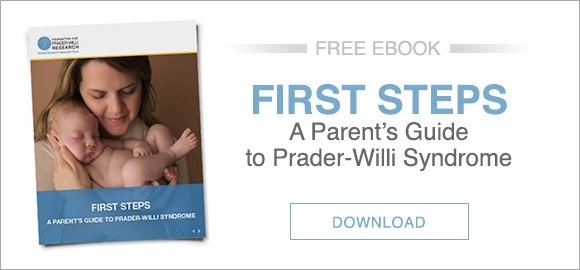Below you'll find the abstract for a newly published paper trying to narrow down exactly which DNA sequences in the PW region of chromosome 15 are responsible for PWS.
Here, the authors investigate a patient who meets the diagnostic criteria of PWS, but is considered to be relatively mildly affected. Study of his chromosomes revealed that he had a translocation in which a portion of chromosome 15 (in the PWS region) was switched out with a portion of chromosome 4. Translocation patients are rare, but they often provide critical information that helps in localizing the exact DNA region responsible for genetic diseases. Here, the interesting thing is that some of the genes previously suggested to perhaps play a role in PWS (including necdin, MAGEL2, SNURF/SNRPN) appear to be intact (caveat - the very end of the SNRPN gene is gone). Because they are intact and this patient has PWS, it means the critical genes may be those encoding the potential regulatory RNAs (snoRNAs). This paper provides another piece of information that strongly implicates the snoRNAs (and snoHBII-85 in particular) as being responsible for PWS characteristics, but it doesn't absolutely rule out the contribution of SNRPN (or nearby genes) to the PWS characteristics.
A couple of interesting points:
-Many of you will recognize that Dr. Francke, the senior author, is supported by FPWR, although not for the study published in this article. In fact, the work that FPWR is supporting seeks to make a mouse model of PWS by knocking out the specific snoRNAs that her group believes is responsible for the PWS characteristics. By specifically knocking out only those particular sequences and looking for mouse PWS characteristics, they hope to formally demonstrate the underlying role of these RNAs in PWS.
-The paper is published in a new 'online' journal - Biomed Central-Medical Genetics. All Biomed Central articles are freely available immediately and in full detail to the public. Even the first version of the submitted manuscript and reviewer comments are there, and can provide some interesting insight into the articles. By wandering around in Biomed Central and looking at the articles, you can probably get an idea of the (not perfect, but works well most of the time) scientific process.
Molecular breakpoint cloning and gene expression studies of a novel translocation t(4;15)(q27;q11.2) associated with Prader-Willi syndrome. B Schüle, M Albalwi1, E Northrop , D I Francis, M Rowell, HR Slater , RJ McKinlay Gardner, U Francke
BMC Medical Genetics 2005, 6:18 doi:10.1186/1471-2350-6-18
Background
Prader-Willi syndrome (MIM #176270; PWS) is caused by lack of the paternally-derived copies, or their expression, of multiple genes in a 4 Mb region on chromosome 15q11.2. Known mechanisms include large deletions, maternal uniparental disomy or mutations involving the imprinting center. De novo balanced reciprocal translocations in 5 reported individuals had breakpoints clustering in SNRPN intron 2 or exon 20/intron 20. To further dissect the PWS phenotype and define the minimal critical region for PWS features, we have studied a 22 year old male with a milder PWS phenotype and a de novo translocation t(4;15)(q27;q11.2).
Methods
We used metaphase FISH to narrow the breakpoint region and molecular analyses to map the breakpoints on both chromosomes at the nucleotide level. The expression of genes on chromosome 15 on both sides of the breakpoint was determined by RT-PCR analyses.
Results
Pertinent clinical features include neonatal hypotonia with feeding difficulties, hypogonadism, short stature, late-onset obesity, learning difficulties, abnormal social behavior and marked tolerance to pain, as well as sticky saliva and narcolepsy. Relative macrocephaly and facial features are not typical for PWS. The translocation breakpoints were identified within SNRPN intron 17 and intron 10 of a spliced non-coding transcript in band 4q27. LINE and SINE sequences at the exchange points may have contributed to the translocation event. By RT-PCR of lymphoblasts and fibroblasts, we find that upstream SNURF/SNRPN exons and snoRNAs HBII-437 and HBII-13 are expressed, but the downstream snoRNAs PWCR1/HBII-85 and HBII-438A/B snoRNAs are not.
Conclusion
As part of the PWCR1/HBII-85 snoRNA cluster is highly conserved between human and mice, while no copy of HBII-438 has been found in mouse, we conclude that PWCR1/HBII-85 snoRNAs is likely to play a major role in the PWS- phenotype.
© 2005 Schle et al; licensee BioMed Central Ltd.
This is an Open Access article distributed under the terms of the Creative Commons Attribution License (http://creativecommons.org/licenses/by/2.0), which permits unrestricted use, distribution, and reproduction in any medium, provided the original work is properly cited.








